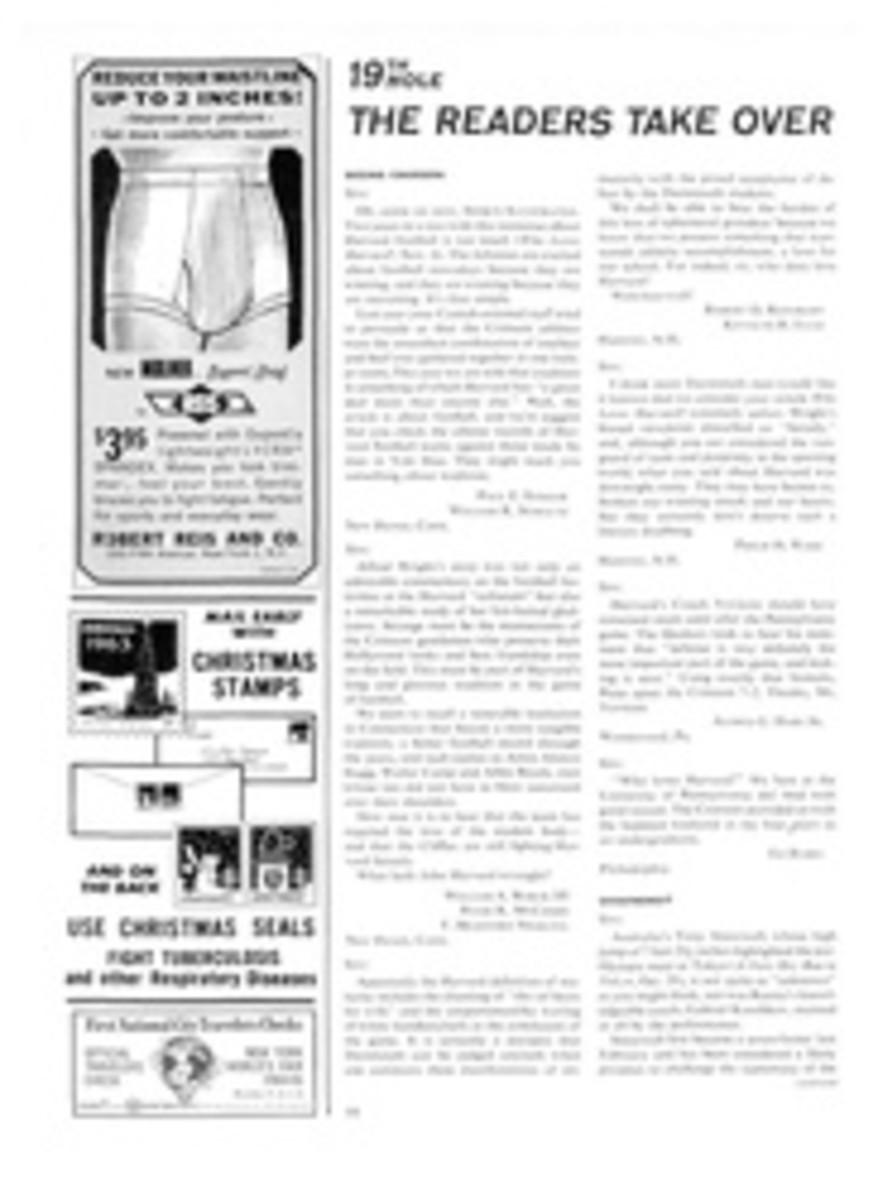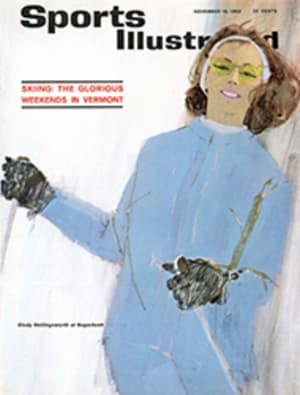
IT'S WINTERTIME, SO LET'S PLAY TENNIS
The tennis fans of Connecticut and its neighboring states are a hardy lot—at least, a significant and growing number of them are. When winter winds begin to howl and snow blankets their courts, these intrepid racketeers neither give up their ball-banging nor take up squash; they deck themselves instead in a special kind of warm winter finery and move on to a structure of wood and wire to play a game called platform tennis.
Not quite tennis, not quite squash, not quite even the paddle tennis familiar to city parks and playgrounds, platform tennis derives from all of them and has a special distinction of its own: it is ideally suited to bad weather. Usually made of Douglas fir or an exceptionally weather-resistant mahogany from Australia, the tennis platform is 60 feet long and 30 feet wide and is completely enclosed by a wire fence 12 feet high. The doubles court measures 44 feet by 20 and gives players plenty of room to maneuver at the sides of the court and behind the baseline. The singles court is the same length but four feet narrower. However, average players undertake singles with the greatest reluctance, since the game is considered too strenuous for one man on a side. The playing surface is covered with a gritty, sand-filled paint to provide nonskid footing in slippery weather. Quarter-inch spaces between the boards make it easy to sweep away rain or slush, and removable boards at the side of the court simplify snow clearance. The platform-tennis ball is durable sponge rubber, painted a bright phosphorescent orange for high visibility in all weather conditions. It is heavier than a tennis ball and hence more stable in gusts of wind. The racket is made of sturdy wood, drilled with holes to lessen wind resistance.
For the most part, the rules governing platform tennis are the same as those governing lawn tennis, and the scoring is identical. Standard tennis strokes like the lob, the overhead smash, the drop shot and the drop volley are an important part of every platform player's repertoire. There are, however, significant differences in the two games. For one, the platform player is allowed only one serve instead of two—a rule that reduces the emphasis on service. For another, the platform player can take a shot on the rebound off the wire fencing that surrounds the court, provided the ball already has bounced once in his court.
It is this rule and the existence of the fence that largely determine the tactics of platform tennis. Neophytes soon discover that the sharply angled smash and sizzling drive of the standard game are not the most effective shots in platform. Caught on the rebound off the fence, such smashes can be returned innumerable times, making the offensive team do the job all over again. One defending player can miss the ball entirely, and his partner, covering for him, can pluck it off the fence and return it. In some cases, if a smash hit by the attacking team rebounds high enough, or far enough away from the fence, the smasher may find himself looking into the mouth of a cannon. A patient team, ceaselessly scraping smashes off the fence, can win points simply by waiting for its opponents to hit the ball out of the court or into the net. If the slammer slams the ball into his opponents' court so violently that it bounces over the fence, the point is a let and must be played over. Rules discouraging slams also save players from having to trudge through snow-banks in search of the ball.
The existence of the fence as a prime tactical factor has made a stroke called the smother shot one of the most effective in the game. This is a soft smash struck almost vertically with a good deal of wrist, so that the ball develops a high trajectory and, coming down, barely brushes the back fence, giving the receiver very little room to swing his paddle at the ball. The resultant tense huddling by the fence and the fact that platform players spend much of their time facing away from the net give the game an air peculiarly apart. This distinctive quality is further evidenced in the attitudes and costumes of its devotees.
Platform tennis had its beginning in 1928 when Fessenden S. Blanchard, a marketing consultant of Scarsdale, N.Y., and his friend, the late James K. Cogswell, started to play a kind of paddle tennis on a board court to keep fit in bad weather. To avoid having to chase the ball down the road or into a neighbor's yard, Messrs. Blanchard and Cogswell erected a wire backstop on their court. Then, one winter, the most electrifying event in the history of the game occurred. One of Blanchard's opponents hit a ball that landed in court, flew up and stuck in the backstop. "It's still in play!" cried the fiery Blanchard, a fearless improviser when it came to rules. He ran around behind the fence, gave the ball a terrific swat and sent it back into the court of his opponents. Catching the spirit of the moment, Blanchard's partner fought off the attacks of their adversaries until Blanchard made his way back into court. At last they won the point. After some (occasionally heated) discussion, the rule permitting the taking of a ball off the backstop was accepted, and a revolutionary new game was born.
The game has turned out to be surprisingly popular. Because it is much easier to catch on to than tennis, beginners can join the fun after a few practice swats. Because power is not a vital factor, ladies play as enthusiastically as men, and husbands can team up with wives in mixed doubles without danger of sardonic comments and injured looks. Scores of husband-and-wife teams have entered the national mixed doubles championships in platform tennis' short history, while very few husband-and-wife teams have competed for the U.S. mixed doubles tennis championship. Oldsters, taking in the heady tang of the chill air, frisk around like young men of 20 when they step on the court. And there is an air of cheery sociability and sportiveness
about the game, akin to the spirit encountered at a ski slope.
Sociologists, in fact, might find a fertile field of study in the modes and mores that have grown up around platform tennis in New York's exurbs. In Darien, Scarsdale, Hartford and New Canaan it is played with an attitude that seems in part, at least, a revolt against the white-flannel orthodoxy of summertime tennis. It is traditional for exurbanite players to arrive at the court wearing raccoon coats or wildly patterned parkas. Flight boots or floppity galoshes are worn over sneakers or, better yet, over durable deck shoes. The mortality rate of rubber soles on the sanded surface of the court is high. Regardless of their income bracket, the men wear old flannel trousers festooned with bright patches. (The right trouser knee of right-handed players takes a terrible beating from all the stooping and scooping necessary to return low shots.) A patch in the shape of a heart is a favorite. Head coverings are equally imaginative: derbies, shakos, busbies, natty Alpine hats with brushes, rowing and baseball caps, Sherlock Holmes deerstalker hats, skating caps, fur hats. The ladies are slightly more conservative, wearing slacks or stretch pants of various bright hues, ski sweaters, ear muffs and heavy gloves. One lady from Short Hills, N.J., trying to raise the general level of fashion, wears an all-gold costume.
After the players have warmed up, they go into an act generally known as the platform-tennis striptease—off come the wintry garments one by one until a player is down to trousers or stretch pants and a ski shirt. Players are warned, however, not to roll up their sleeves lest a sudden gust of chill wind give them the equivalent of tennis elbow. Hot coffee is taken to the courts in thermoses or percolated on the spot for those waiting their turn to play. A few platform clubs, such as the New Canaan (Conn.) Field Club, have special warming huts to thaw out chilled players in severely cold weather.
The equipment necessary to all this enjoyment—a wooden court complete with galvanized wire fence, galvanized hardware, creosoted timber supporting the deck, kiln-dried platform lumber and concrete foundation piers—costs about $5,000 and can be erected by professionals in a few weeks. Because of the inevitable rush of enthusiasts to any court once it is up, the American Platform Tennis Association recommends that private clubs, such as tennis clubs, erect two courts rather than one.
Many tennis clubs, many organizations that are not tennis clubs and many individuals have taken the APTA's advice. Iowa's Grinnell College has two courts, and so has Hotchkiss in Lakeville, Conn. The West Side Tennis Club in metropolitan Forest Hills, N.Y. has two courts and so does the rural Merion Cricket Club. A private devotee has built himself a court on the edge of a cliff in a location well-calculated to make his opponents air sick as they aim serves toward what appears to be empty space.
Those who have played on these and other courts range, on the male side, from Don Budge and Bill Talbert to Pollster George Gallup and Artist Eldridge King, who drew the pictures on these pages. The spectrum among the women is equally wide. Each year there are increasing numbers of special tournaments: father-son tournaments, father-daughter tournaments, mother-daughter tournaments, and extra-special ones called scrambles (all-male tournaments in which good players are carefully paired with those not so proficient, so that all can have a go at the trophy) and "jambles" (tournaments in which the better men players are paired with the worse women, and vice versa, again in the interest of evening the odds).
According to the APTA, an organization of 70 platform-tennis clubs, there are now close to 25,000 people who play the game without regard to snow, sleet, storm, rain nor dark of night (many courts are floodlit with 1,500-watt lamps). In fair weather and foul, from October to April, when tennis players, skiers, ice skaters and golfers are fretting and fuming because there is not enough snow or too much of it, because it is too cold or too warm, because it is too hot or too dry, these platform tennis enthusiasts are happily crying "Take it!" "Mine!" or "Let it go!" "It circulates the blood, improves the breathing and whets the appetite," asserts one platform-happy fan. "It gives you," says another, "something to worry about all winter."
ILLUSTRATION
ELDRIDGE KING
Frostbitten players at the New Canaan (Conn.) Field Club's platform tennis court can thaw out between sets in a cozily heated pagoda.
ILLUSTRATION
ELDRIDGE KING
Plat form tennis demands a uniform all its own motley, unorthodox but nonetheless practical.
TWO ILLUSTRATIONS
ELDRIDGE KING
ILLUSTRATION
ELDRIDGE KING
A tennis platform of fir or mahogany, supported on concrete and fenced with wire, costs $5,000.

